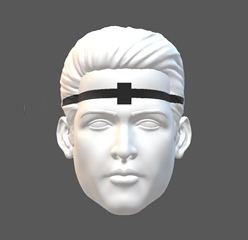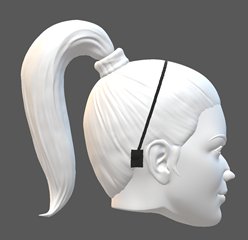What is bone conduction testing?
“Bone conduction is the conduction of sound to the inner ear, primarily through the bones of the skull, allowing the hearer to perceive audio content without blocking the ear canal.”1
Instead of using an earphone, bone conduction audiometry uses an electromechanical bone conductor or bone oscillator (a small square box on the end of a metal headband) which is placed on the skull; usually on the mastoid prominence or forehead to stimulate the cochlea directly, bypassing the outer and middle ear.
How does bone conduction work?
A bone conduction hearing test works by performing the role of the eardrums, transmitting sound vibrations through the bone. It’s designed to pick up sound, amplify it, and convert it into a vibration that can be received directly by the cochlea. The sound reaches the ears as vibrations through the bones (or skull) and skin, so the eardrum is never involved.
A bone conduction hearing device is an alternative to a regular hearing aid for those with problems in their outer or middle ears. It’s useful to note that it relies on a working cochlea to send sound to the brain.
Air conduction vs bone conduction
The primary difference between air conduction and bone conduction lies in the pathway through which sound waves travel to reach the inner ear. Both are important in understanding hearing and hearing impairments.
Unlike bone conduction, air conduction relies on the transmission of sound waves through the air. It involves the normal hearing process through the outer, middle, and inner ear. Air conduction is the most basic and easiest test to administer as it’s completed via a set of headphones. This process will only find if there’s a decrease or loss in sensitivity.
In contrast, bone conduction helps to determine the type and degree of hearing loss by bypassing the outer and middle ear and directly stimulating the cochlea.
Bone conduction headband placement
There are two placement areas for the oscillator: the forehead and the mastoid bone. To obtain the most accurate results, the bone oscillator must be properly placed. The positioning will depend on the audiologist or hearing professional's preferred way of working, but we’ll explore the options below:
Forehead placement
Many audiologists prefer the bone oscillator placement to be on the forehead, as it’s often perceived to be the simplest way to test. The oscillator is usually attached to a soft headband which can be easily adjusted to fit the size of the patient’s head. Proper placement for the oscillator is in the center of the forehead just above the eyebrows.
Mastoid placement
According to a survey by Martin, Champlain & Chambers, mastoid is the most widely used type of placement.4 This is where an oscillator is attached to a metal headband and placed on the mastoid bone. It needs to be placed close to (but not touching) the pinna.
Placement on the mastoid bone can be tricky, as they’re not all shaped the same. Head size can also play a factor in how well the headband will stay in place. If you have trouble with mastoid placement on one side, it’s a good idea to try the other side, to see if the oscillator will better stay in place there.
It is important to note that there is a difference in intensity levels when performing testing via the forehead and the mastoid. To obtain a response from the forehead, the intensity has to be 10 dB louder than when obtaining a response from the mastoid.5 The best way to work around this issue is to have the equipment calibrated for the preferred testing placement.
 |
 |
| Forehead placement |
Forehead placement |
Diagnostic audiometers
Amplivox has developed a suite of innovative and user-friendly diagnostic audiometers to diagnose a range of hearing loss pathologies.
The Model 270+ is an advanced diagnostic audiometer - a popular choice for audiologists, ENTs and hearing aid suppliers. It includes manual and automatic testing for bone conduction, as well as air conduction (Hughson Westlake and Békésy), plus intuitive tools that enable hearing professionals to diagnose hearing loss issues quickly and efficiently.
With bone conduction testing, masking becomes vital to differentiate the side of hearing loss, so the masking assistant supports hearing care professionals to accurately diagnose this.
For more information on our range of diagnostic audiometers for bone conduction and other tools, please visit our audiometers webpage, contact our customer support team on +44 (0)1865 880 846 or email.
References
1Wikipedia. Bone Conduction. Accessible at:
https://en.wikipedia.org/wiki/Bone_conduction
2From: Handbook of Clinical Neurology, 2015
3Paul W. Flint MD, FACS. Bone Conduction. ScienceDirect. Accessible at:
https://www.sciencedirect.com/topics/medicine-and-dentistry/bone-conduction
4Martin, F.N., Champlin, C., & Chambers, J.A. (1998). Seventh survey of audiometric practices in the United States. Journal of the American Academy of Audiology, 9 2, 95-104.2
5Martin, F. N., & Clark, J. G. (2019). Introduction to Audiology. Pearson